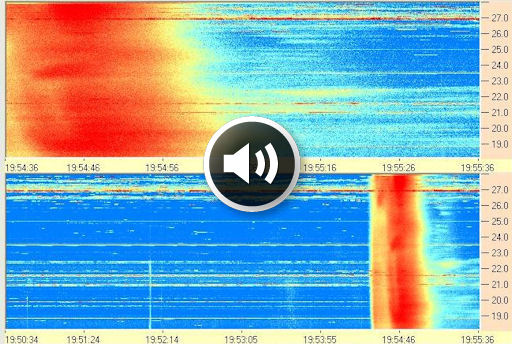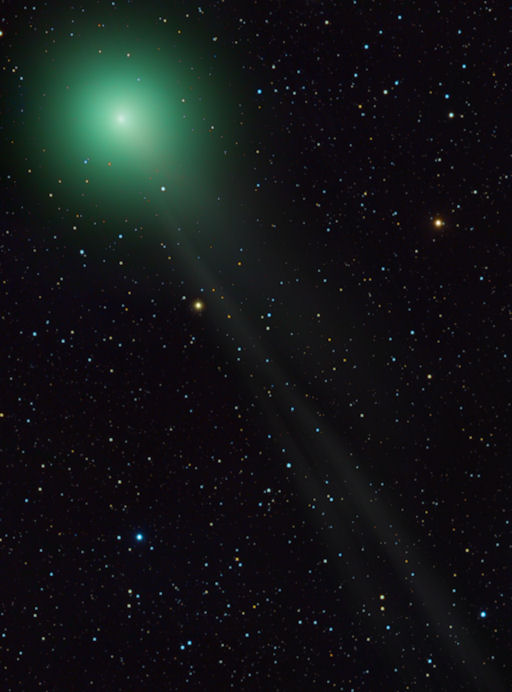SUNSPOT OF INTEREST: A break in the quiet could be in the offing. Sunspot AR1667 is crackling with C-class solar flares and appears capable of producing an even stronger M-class eruption. The sunspot is turning toward Earth, so future blasts would likely be geoeffective. Solar flare alerts: text, voice.
LOUD SOLAR RADIO BURST: Yesterday, Feb. 2nd, the solar activity forecast called for "quiet." In fact, says amateur radio astronomer Thomas Ashcraft, "it was really loud. There were several strong solar radio emissions including one super-strong Type III burst at 1954 UT. I captured it at 28 MHz and 21.1 MHz as it totally drowned out a short wave voice transmission." Click on the image to listen:

Dynamic spectrum credit: Dick Flagg, Windward Community College Radio Observatory, Oahu, Hawaii
The source of the burst was sunspot AR1667, which unleashed a C2.9-class solar flare just before the roar emerged from the loudspeaker of Ashcraft's radio telescope. Type III solar radio bursts are produced by electrons accelerated to high energies (1 to 100 keV) by solar flares. As the electrons stream outward from the sun, they excite plasma oscillations and radio waves in the sun's atmosphere. When these radio waves head in the direction of Earth, they make themselves heard in the loudspeakers of shortwave radios around the dayside of the planet.
More radio bursts could be in the offing. Sunspot AR1667 is crackling with C-class solar flares and seems poised for even stronger M-class eruptions. Solar flare alerts: text, voice.
Realtime Space Weather Photo Gallery
COMET LEMMON UPDATE: Glowing much brighter than expected, Comet Lemmon (C/2012 F6) is gliding through the skies of the southern hemisphere about 92 million miles (0.99 AU) from Earth. Amateur astronomer Rolf Wahl Olsen sends this picture from his backyard in Auckland, New Zealand:
"I took this image of Comet Lemmon on the 28th of January," says Olsen. "It has become quite bright now and has also grown a beautiful tail."
Discovered on March 23rd 2012 by the Mount Lemmon survey in Arizona, Comet Lemmon is on an elliptical orbit with a period of almost 11,000 years. This is its first visit to the inner solar system in a very long time. The comet is brightening as it approaches the sun; light curves suggest that it will reach 2nd or 3rd magnitude, similar to the stars in the Big Dipper, in late March when it approaches the sun at about the same distance as Venus (0.7 AU).
At the moment, the comet is glowing like a 7th magnitude star, just below the limit of naked-eye visibility. To capture the faint details of the comet's filamentary tail, Olsen used a 10-inch telescope, a sensitive CCD camera, and an exposure time of 1 hour 17 minutes. Complete photo details are given here.
Lemmon's green color comes from the gases that make up its coma. Jets spewing from the comet's nucleus contain cyanogen (CN: a poisonous gas found in many comets) and diatomic carbon (C2). Both substances glow green when illuminated by sunlight in the near-vacuum of space.
Northern hemisphere observers will get their first good look at the comet in early April; until then it is a target exclusively for astronomers in the southern hemisphere

![]()
Solar wind
speed: 403.1 km/sec
density: 3.9 protons/cm3
explanation | more data
Updated: Today at 2337 UT
![]()
X-ray Solar Flares
6-hr max: C1 1803 UT Feb03
24-hr: C8 0610 UT Feb03
explanation | more data
Updated: Today at: 2300 UT
![]()
![]()
![]()
Daily Sun: 03 Feb 13
![]()
![]()
None of these sunspots is actively flaring. Credit: SDO/HMI
![]()
![]()
![]()
Sunspot number: 54
What is the sunspot number?
Updated 03 Feb 2013
Spotless Days
Current Stretch: 0 days
2013 total: 0 days (0%)
2012 total: 0 days (0%)
2011 total: 2 days (<1%)
2010 total: 51 days (14%)
2009 total: 260 days (71%)
Since 2004: 821 days
Typical Solar Min: 486 days
Update 03 Feb 2013
The Radio Sun
10.7 cm flux: 112 sfu
explanation | more data
Updated 03 Feb 2013
![]()
![]()
![]()
Current Auroral Oval:
![]()
Switch to: Europe, USA, New Zealand, Antarctica
Credit: NOAA/POES
![]()
![]()
![]()
Planetary K-index
Now: Kp= 1 quiet
24-hr max: Kp= 2 quiet
explanation | more data
![]()
Interplanetary Mag. Field
Btotal: 4.6 nT
Bz: 0.2 nT north
explanation | more data
Updated: Today at 2336 UT
![]()
![]()
![]()
Coronal Holes: 02 Feb 13
![]()
![]()
Solar wind flowing from these coronal holes should reach Earth between Feb. 4th and 6th. Credit: SDO/AIA.





